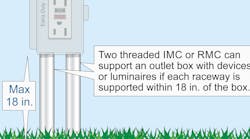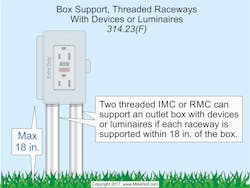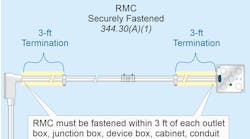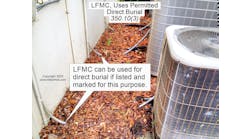All questions and answers are based on the 2017 NEC.
Underlined text indicates a Code change.
Q. What are the Code rules for allowable support means of boxes and conduit bodies?
A. Boxes can be fastened to any surface that provides adequate support [Sec. 314.23(A)].
Boxes can be supported from any structural member, or they can be supported from grade by a metal, plastic, or wood brace [Sec. 314.23(B)].
Nails or screws used as a fastening means, must secure boxes by using outside brackets or by using mounting holes in the back or in a single side of the box, or pass through the interior within ¼ in. of the back or ends of the box. Screws aren’t permitted to pass through the box unless the exposed threads in the box are protected using approved means to avoid abrasion of conductor insulation. Mounting holes made in the field to support boxes must be approved by the authority having jurisdiction [Sec. 314.23(B)(1)].
Metal braces no less than 0.02 in. thick and wood braces not less than a nominal 1 in. × 2 in. can support a box [Sec. 314.23(B)(2)].
Boxes can be secured to a finished surface (drywall or plaster walls, or ceilings) by clamps, anchors, or fittings identified for the purpose [Sec. 314.23(C)].
Outlet boxes 100 cu in. or less can be supported to the structural or supporting elements of a suspended ceiling, if securely fastened by any of the following methods [Sec. 314.23(D)]:
(1) Ceiling‑Framing Members. An outlet box can be secured to suspended‑ceiling framing members by bolts, screws, rivets, clips, or other means identified for the suspended‑ceiling framing member(s). If framing members of suspended‑ceiling systems are used to support luminaires, they must be securely fastened to each other and must be securely attached to the building structure at appropriate intervals. In addition, luminaires must be attached to the suspended‑ceiling framing members with screws, bolts, rivets, or clips listed and identified for such use [Sec. 410.36(B)].
(2) Independent Support Wires. Outlet boxes can be secured with identified fittings to the ceiling‑support wires. If independent support wires are used for outlet box support, they must be taut and secured at both ends [Sec. 300.11(B)]. See Sec. 300.11(B) on the use of independent support wires to support raceways and cables.
(3) Raceway — Supported Boxes and Conduit Bodies Without Devices or Luminaires. Two intermediate metal or rigid metal conduits, threaded wrenchtight into the enclosure, can be used to support an outlet box that doesn’t contain a device or luminaire, if each raceway is supported within 36 in. of the box or within 18 in. of the box if all conduit entries are on the same side [Sec. 314.23(E)].
Exception: Conduit bodies are permitted to be supported by any of the following wiring methods:
• Intermediate metal conduit, Type IMC
• Rigid metal conduit, Type RMC
• Rigid polyvinyl chloride conduit, Type PVC
• Reinforced thermosetting resin conduit, Type RTRC
• Electrical metallic tubing, Type EMT.
(4) Raceway — Boxes and Conduit Bodies with Devices or Luminaires. Two intermediate metal or rigid metal conduits, threaded wrenchtight into the enclosure, can be used to support an outlet box containing devices or luminaires, if each raceway is supported within 18 in. of the box [Sec. 314.23(F)] (see Figure).
Pendant Boxes containing a hub can be supported from a flexible cord connected to fittings that prevent tension from being transmitted to joints or terminals [Sec. 314.23(H)(1) and Sec. 400.10].





